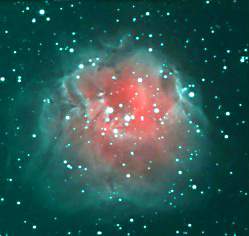
(JPEG 50 Ko) © Copyright 2001 CNRS/OHP

(JPEG 50 Ko) © Copyright 2001 CNRS/OHP
|
Cette photo de la région HII Sharpless 212, construite par Lise Deharveng à partir d'images CCD prises au 1m20 de l'OHP (observations de service effectuées par Didier Gravallon) est parue le 18 décembre 2001 dans le site web Astronomy Picture of the Day |
I am interested in this region for several reasons. First, this bright (thus easy to observe) HII region lies far from the Galactic center, and as such, it is a choice region to study the abundance of elements and see how it decreases from the center to the edge of our Galaxy. It is what we have done for oxygen (Deharveng et al., 2000, MNRAS 311, 329). Second, our group is interested by sequential massive-star formation, as observed at the border of HII regions. Sh212 is part of a group of HII regions selected for this study thanks to the MSX IR survey (Egan et al., 1999, Explanatory guide); they are spherical, surrounded by dusty annular photo-dissociation regions into which massive stars, or even clusters, are presently forming.
This false-color image results from the combination of two frames obtained with a TK1024 CCD camera at the 1.2-m telescope of the Observatoire de Haute Provence (OHP). One frame was obtained through a narrow H-alpha filter (at 6563 A); it shows, in pink, the emission of the ionized hydrogen, and thus described the whole HII region. Another filter selected the emission of the S+ ion (two lines at 6717 and 6731A); it shows, in turquoise, the edges of the ionized nebula, the high-density zones close to the ionization fronts which separate the ionized and the neutral material.
These frames were obtained by Didier Gravallon, in service observing mode.
Lise
Deharveng
Université de Provence
Laboratoire d'Astrophysique
de Marseille